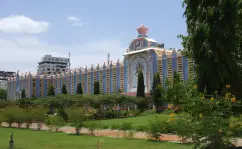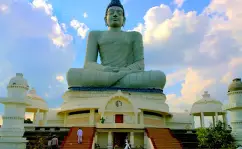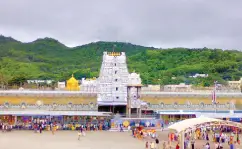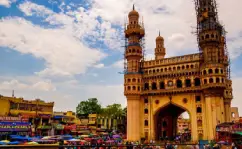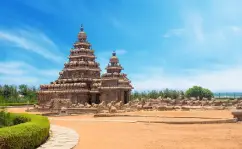10 Best Temples to Visit in Andhra Pradesh: Awaken Your Spiritual Significance
Andhra Pradesh, a state of mystical places, is one of the most preferred destinations to spend time and connect with historical India. It is a hub for spiritual seekers, as it is home to a collection of popular pilgrimage centers, timeless temples, and other places that attract visitors from all over the world. Visit Andhra Pradesh to explore its ancient historical and architectural temples that tell the long tale of its past. Here are the 10 best Hindu temples to visit in the most popular cities of Andhra Pradesh, including Vijayawada, Visakhapatnam, Tirupati, Kurnool, and Guntur, to make Andhra Pradesh pilgrimage itinerary most enjoyable.
|
Name of the Hindu Temple
|
Location
|
|
Tirumala Venkateswara Temple
|
Tirupati
|
|
Yaganti Temple
|
Nandyal
|
|
Ahobilam Temple
|
Kurnool
|
|
Simhachalam Temple
|
Visakhapatnam
|
|
Kanaka Durga Temple
|
Vijayawada
|
|
Siva Mallikarjuna Temple
|
Srisailam
|
|
Kanipakam Vinayaka Temple
|
Chittoor
|
|
Mangalagiri Temple
|
Mangalagiri
|
|
Ranganatha Temple
|
Nellore
|
|
Srikalahasti Temple
|
Tirupati
|
Tirumala Venkateswara Temple
The abode of Lord Vishnu in the age of Kali, known as "Kalyug," is Tirumala Venkateswara Temple, also referred to as Balaji Temple. The temple holds great historical significance and is believed to be the earthly manifestation of "vaikuntam," making it a revered Hindu pilgrimage site. It ranks among the most visited temples in India, with millions of people coming here seeking the blessings of Lord Venkateswara. The architectural brilliance and grandeur of the temple, set amidst lush green hills and nature, provide a visual retreat for visitors. Strict rules are in place to witness the idol of Lord Venkateswara, ensuring a smooth worship experience for devotees. The temple follows various rituals and celebrates festivals on a grand scale. Additionally, the temple administration offers different facilities for accommodation to ensure a comfortable visit.
Architecture of the Temple
The Tirumala Venkateswara Temple is a marvel of architectural craftsmanship, intricately carved into the historical pilgrimage site dedicated to Lord Venkateswara. The temple's Gopuram, or entrance structure, showcases exquisite artwork depicting gods, goddesses, celestial beings, and mythological stories. The towering structures within the temple premises narrate the divine life of the deity. Inside the sanctum sanctorum (Garbhgriha), the idol of Lord Venkateswara resides. The remarkable craftsmanship displayed throughout the temple is truly awe-inspiring. Every aspect of the temple, when observed closely, reveals meticulous attention to detail and precise measurements. The ratios and proportions of each part of the temple exhibit a perfect symmetry. As you explore this architectural heritage, you will gain a deeper appreciation for the various rulers who played a role in its establishment.
Special Things to Know About the Temple
- The temple attracts hundreds of thousands of devotees daily, especially on special occasions.
- The Tirumala Venkateswara Temple is dedicated to Lord Venkateswara, an incarnation of Lord Vishnu.
- The temple receives significant donations in the form of money, gold, and other valuable items.
- A unique ritual at the temple involves devotees shaving their heads and donating their hair, which is then sold to contribute to the temple's funds.
- The temple hosts numerous festivals throughout the year, offering opportunities for visitors to participate and partake in the celebrations.
- A special daily auction takes place for the first laddu (a sweet treat) made, with the highest bidder securing the purchase.
Visiting Hours - 5 AM to 11 PM (until 1 PM in the peak season).
How to Reach?
Tirupati is well-connected by regular bus services from nearby cities, including Bangalore, Chennai, and Vellore. The nearest railway station is 25 km away, and the nearest airport is 15 km away.
Yaganti Temple
Yaganti Temple, located in the Kurnool district of Andhra Pradesh, is one of the majestic temples of Lord Shiva in a unique form. It is believed that the penance of sage Agastya led to the manifestation of Lord Shiva and Goddess Parvati in the form of Ardhanarishvara. Surrounded by picturesque hills, the temple creates a serene and enchanting atmosphere. One notable feature of this temple is the natural rock formation known as "Umamaheshwara Sannidhi," which is believed to be growing in size. Within the temple complex, there are also shrines dedicated to deities such as Parvati and Venkateswara. Yaganti Temple's rich cultural heritage, natural beauty, and spiritual significance make it a cherished destination for seekers of divinity and religious tourism.
Architecture of Temple
The architecture of the Yaganti Temple is a splendid testament to the mastery of ancient craftsmanship. Built in the Vijayanagara style, the temple showcases intricate carvings and sculptures that depict mythological stories and celestial beings. The main sanctum sanctorum is a remarkable fusion of Dravidian and Nagara architectural styles. The temple's pillars are adorned with exquisite carvings of deities, divine beings, and intricate floral motifs. The stone walls and ceilings bear inscriptions from different dynasties that once ruled the region, adding a historical dimension to the temple's antiquity. Yaganti Temple stands as a remarkable architectural marvel, preserving the rich heritage of the bygone eras.
Special Things to Know About the Temple
- Yaganti Temple is renowned for housing the largest monolithic Nandi statue in the world.
- Within the temple premises, there is a natural rock formation called "Umamaheshwara Sannidhi." It is believed that the rocks in this chamber gradually increase in size, defying scientific explanation.
- The temple complex features a sacred tank known as Pushkarini, where a dip is believed to cleanse one's sins and grant spiritual purification.
- The temple holds great significance as one of the sacred places blessed by the presence of sage Agastya.
- Various festivals are celebrated at the temple throughout the year, including Maha Shivaratri, Brahmotsavam, and Karthika Deepotsavam.
- Yaganti Temple stands out for its unique location partially within a natural cave. The cave houses the sanctum sanctorum of Lord Venkateswara, attracting devotees seeking the blessings of the deity.
- The temple's architecture is adorned with intricate carvings and sculptures depicting gods, goddesses, and mythological tales. The stone carvings showcase remarkable craftsmanship, reflecting the artistic excellence of ancient artisans.
Visiting Hours
- Morning: 7 AM to 11 AM
- Afternoon: 3 PM to 8 PM
How to Reach?
The nearest railway station to the temple is Rangpuram railway station. From there, you can take bus routes to reach the temple.
Ahobilam Temple
Ahobilam Temple, nestled amidst the picturesque hills of the Eastern Ghats, is one of the revered Hindu temples in Andhra Pradesh, India. It is dedicated to Lord Narasimha, an incarnation of Lord Vishnu, and holds great significance for devotees seeking blessings, protection, and spiritual solace. The temple complex is divided into two main shrines, the Upper Ahobilam and Lower Ahobilam, and encompasses nine sacred shrines, each associated with different episodes from Hindu mythology. Ahobilam Temple mesmerizes visitors with its serene ambiance, intricate architecture, and breathtaking natural surroundings, making it a cherished destination for religious and nature enthusiasts.
Architecture of Temple
The architecture of the Ahobilam Temple showcases the exquisite craftsmanship of Andhra Pradesh's temples, reflecting the grandeur of ancient Indian artistry. The temple's design is a remarkable fusion of Dravidian and Vijayanagara architectural styles. Elaborate sculptures and intricate motifs embellish the walls and pillars, depicting mythological tales and celestial beings. The main sanctum sanctorum, known as the Garuda Mandapa, stands as a magnificent structure with meticulous detailing and craftsmanship. Welcoming visitors into a realm of divine splendor, the temple's entrance gate is adorned with sculptures of various deities.
Special Things to Know About the Temple
- Ahobilam Temple is believed to be the sacred place where Lord Narasimha vanquished the demon Hiranyakashipu.
- The temple complex comprises nine shrines, each dedicated to a different form of Lord Narasimha.
- The Upper Ahobilam Temple is perched atop the hills, while the Lower Ahobilam Temple is situated at the foothills.
- Ahobilam Temple is renowned for its exceptional stone carvings and intricate sculptures depicting various mythological tales.
- The temple offers breathtaking panoramic views of the surrounding Eastern Ghats, enhancing its natural beauty.
- Ahobilam Temple is a popular pilgrimage site that draws devotees from all across India.
- The temple celebrates numerous festivals, with the Brahmotsavam being the most significant and grandest celebration.
- A visit to Ahobilam Temple is believed to bestow spiritual liberation and protection from malevolent forces.
- The temple premises also encompass a sacred tank called 'Bhargava Tirtham,' which is believed to possess healing properties.
- Ahobilam Temple is a treasure trove of ancient Indian art, architecture, and religious devotion, providing a profound spiritual experience to its visitors.
Visiting Hours
- Lower Ahobilam: 6:30 am to 1:00 pm and 3:00 pm to 8:00 pm
- Upper Ahobilam: 7:00 am to 1:00 pm and 2:00 pm to 7:00 pm
How to Reach?
Bus services are readily available from nearby districts and cities such as Kurnool, Nandyal, and Hyderabad.
Simhachalam Temple
Simhachalam Temple is located in the scenic city of Visakhapatnam, India. It is one of the most famous Hindu temples in Andhra Pradesh, renowned for its rich cultural heritage and spiritual significance. Dedicated to Lord Narasimha, an avatar of Lord Vishnu, this ancient temple stands majestically atop the Simhachalam Hills, offering breathtaking panoramic views of the surrounding lush greenery. The temple's architecture showcases a blend of traditional Dravidian and Kalinga styles, captivating visitors with intricate carvings, vibrant sculptures, and ornate gateways. Pilgrims flock to Simhachalam Temple to seek blessings, experience divine tranquillity, and participate in vibrant festivals such as Chandanotsavam and Nijaroopa Darshanam, which attract devotees from far and wide.
Architecture of Temple
Simhachalam Temple showcases remarkable architectural antiquity that reflects the brilliance of ancient craftsmanship. The temple's architecture exhibits a fusion of Dravidian and Kalinga styles, characterized by intricate carvings, ornate pillars, and stunning sculptures. The main shrine, adorned with exquisite sculptures depicting various deities and mythological figures, stands as a testament to the artistry of the bygone era. The outer walls feature detailed friezes depicting scenes from Hindu epics, showcasing the mastery of the sculptors. The temple's gopuram (entrance tower) and vimana (tower above the sanctum) display intricate stonework depicting celestial beings and religious motifs, leaving visitors in awe of the architectural grandeur of Simhachalam Temple.
Special Things to Know About the Temple
- Simhachalam Temple is counted among the 108 Divya Desams, which are the holiest abodes of Lord Vishnu.
- The presiding deity, Lord Narasimha, is depicted in a unique and fierce form, half-lion and half-human.
- The temple's sanctum sanctorum houses a self-manifested idol, considered a divine manifestation.
- The temple's architecture beautifully blends Dravidian and Kalinga styles, featuring intricate carvings and sculptures.
- Chandanotsavam, the annual sandalwood paste festival, is a major highlight of the temple, attracting thousands of devotees.
- The temple offers stunning panoramic views of the surrounding hills and greenery, enhancing its natural beauty.
- Simhachalam Temple boasts a sacred waterfall known as Pushkarini, believed to possess healing properties.
- Visiting the temple is believed to grant liberation from sins and bestow divine blessings.
- The temple hosts various religious rituals, festivals, and processions throughout the year, enriching the spiritual experience.
- Simhachalam Temple holds rich historical and cultural significance, with a history spanning several centuries.
Visiting Hours
- The temple is open from 7:00 AM to 9:00 PM every day, with a daily break from 4:00 PM to 6:00 PM.
How to Reach?
Reaching Simhachalam Temple is convenient as it is located close to the city center. It is easily accessible by road, and there are several bus services available directly from the railway station to the temple.
Kanaka Durga Temple
The Kanaka Durga Temple is a renowned Hindu pilgrimage site located in Vijayawada, Andhra Pradesh, India. Dedicated to Goddess Kanaka Durga, it is situated on the Indrakeeladri Hill, overlooking the sacred Krishna River. This ancient temple holds immense religious significance and attracts devotees from far and wide. The presiding deity, Kanaka Durga, is worshipped as the divine mother and is believed to bestow blessings, prosperity, and protection upon her devotees. The temple complex showcases exquisite architecture, adorned with intricate carvings and vibrant decorations. With its rich history and spiritual ambiance, Kanaka Durga Temple holds a prominent position among the famous religious tourist destinations in southern India.
Architecture of Temple
The Kanaka Durga Temple showcases a splendid display of architectural antiquity. The temple's design is a fusion of various styles, including Chalukyan, Chola, and Vijayanagara. The entrance, adorned with a towering Gopuram (ornate gateway), greets visitors with intricate sculptures and vibrant colors. The main sanctum, featuring an idol of Goddess Kanaka Durga, is embellished with exquisite stone carvings and sculptural details. The temple complex also encompasses mandapas (pillared halls) and smaller shrines dedicated to other deities. The architecture exudes a sense of grandeur, capturing the essence of ancient Hindu temple design and standing as a testament to the artistic and architectural prowess of its creators.
Special Things to Know About the Temple
- The Kanaka Durga Temple is situated at a picturesque location atop the hills in the city of Vijayawada.
- The temple is renowned for its grand celebration of Navaratri, attracting a large number of devotees.
- A cable car system is available for visitors to reach the temple comfortably, providing a pleasant view of the surrounding hills.
- During festivals, the temple organizes dance and musical performances, offering a delightful experience for visitors.
- The temple follows the ritual of Akhanda Deepam during Navratri, where a flame is lit continuously for nine days.
Visiting Hours
temple is open from 5:00 AM to 9:00 PM. It remains closed between 1:00 PM to 5:00 PM on Thursdays.
How to Reach?
The Kanaka Durga Temple in Vijayawada is located just 4 kilometers away from Vijayawada railway station. It is well-connected by national highways and railway lines, providing convenient access for devotees and visitors.
Siva Mallikarjuna Temple
The Siva Mallikarjuna Temple is a revered Hindu place of worship located in the town of Srisailam. It is a renowned temple in Andhra Pradesh dedicated to Lord Shiva. The temple holds immense significance for devotees and is considered one of the 12 Jyotirlingas, the sacred abodes of Lord Shiva. With a rich history dating back to ancient times, the temple showcases remarkable architectural brilliance and intricate carvings. Nestled amidst the scenic Nallamala Hills on the banks of the River Krishna, the Siva Mallikarjuna Temple attracts pilgrims from far and wide who seek spiritual solace and blessings from the divine deity, Lord Shiva.
Architecture of Temple
The Siva Mallikarjuna Temple boasts an architectural antiquity that reflects the rich cultural heritage of ancient India. The temple's construction dates back to the 7th century CE, showcasing the characteristic Dravidian architectural style. The temple complex is adorned with intricate sculptures and carvings depicting various mythological stories and deities. The main shrine features a towering gopuram (gateway tower) adorned with intricate motifs and sculptures. The inner sanctum houses the sacred lingam, representing Lord Shiva. The temple's architecture stands as a testament to the skill and craftsmanship of the artisans of yesteryears, captivating visitors with its grandeur and historical significance.
Special Things to Know About the Temple
- The Siva Mallikarjuna Temple is one of the 12 Jyotirlingas, highly revered in Hindu mythology.
- It is situated on the banks of the Krishna River amidst the picturesque Nallamala Hills.
- The temple is dedicated to Lord Shiva and showcases remarkable Dravidian architectural style.
- With a history dating back to the 7th century CE, it is an ancient and revered pilgrimage site.
- The temple complex features intricate sculptures, carvings, and a towering gopuram.
- It attracts a large number of devotees seeking spiritual solace and blessings from Lord Shiva.
- The Lingodbhava sculpture inside the temple is believed to manifest Lord Shiva's divine power.
- The temple is renowned for its annual festival called Maha Shivaratri, which witnesses grand celebrations and religious rituals.
- It holds a significant place in South Indian religious and cultural heritage.
- The Siva Mallikarjuna Temple offers a serene and tranquil ambiance, providing a peaceful environment for devotees to worship and meditate.
Visiting Hours
The temple is open from 4:30 AM to 10:00 PM on all days of the week.
How to Reach?
The nearest railway station to the temple is Markapur Railway Station, which is 81 kilometers away. You can book a bus ride from the nearest cities, or you can reach the temple from the railway station by taxi.
Kanipakam Vinayaka Temple
The Kanipakam Vinayaka Temple is a revered Hindu pilgrimage site located in Kanipakam village, Chittoor district, Andhra Pradesh, India. Dedicated to Lord Ganesha, the temple is renowned for its ancient origins and spiritual significance. The main deity, Lord Vinayaka, is believed to be a swayambhu (self-manifested) idol, granting the temple a special significance in Hindu mythology. The temple's architectural splendor, adorned with intricate carvings and sculptures, captivates devotees and tourists alike. It is also famous for the Kanipakam Maha Ganapathi Rathotsavam, a grand procession celebrated annually, which attracts thousands of devotees from far and wide. The temple stands as a cherished spiritual destination in South India.
Architecture of Temple
The architectural antiquity of the Kanipakam Vinayaka Temple is awe-inspiring. The temple showcases the rich heritage of South Indian temple architecture. Built in the Dravidian style, it boasts intricate carvings and sculptures depicting various mythological stories and deities. The entrance tower, adorned with elaborate sculptures, stands tall as a testament to the temple's grandeur. The inner sanctum houses the swayambhu idol of Lord Vinayaka, exuding a sense of divine energy. The temple complex also includes a beautiful Pushkarini tank, adding to its aesthetic charm. The architectural antiquity of the Kanipakam Vinayaka Temple transports visitors to a bygone era of architectural mastery and artistic brilliance.
Special Things to Know About the Temple
- The Kanipakam Vinayaka Temple is renowned as the only temple in the world where Lord Ganesha is worshipped in his sitting posture.
- The temple's main attraction is the swayambhu idol of Lord Vinayaka, which is believed to be growing in size over the years.
- The temple tank, Pushkarini, is considered to have medicinal properties, and devotees take a dip in its holy waters to seek blessings and cure ailments.
- The temple is known for its unique tradition of offering hair as a form of prayer, and devotees often shave their heads as an act of devotion.
- The annual Kanipakam Maha Ganapathi Rathotsavam is a grand chariot procession that draws thousands of devotees, showcasing the vibrant and festive spirit of the temple.
- The temple is home to a special elephant named Varasiddhi Vinayaka Swamy, who is considered sacred and believed to possess divine powers.
Visiting Hours
The temple is open from 4 AM to 9 PM on all days of the week.
How to Reach?
To reach the temple, you can travel by air or rail to Tirupati and then take advantage of the frequent state bus services that operate to the temple.
Mangalagiri Temple
Mangalagiri Temple, situated in the town of Mangalagiri in the Indian state of Andhra Pradesh, is one of the must-visit temples in Andhra Pradesh. This ancient temple holds great significance in Hindu mythology and attracts devotees from all over the country. Dedicated to Lord Narasimha, an incarnation of Lord Vishnu, the temple is perched on a hill known as "Mangalagiri" or "Auspicious Hill." It is believed that a visit to this sacred shrine brings blessings and fulfills the wishes of the devotees. The temple's architectural beauty, spiritual ambiance, and cultural heritage make it a captivating destination for curious visitors and a significant part of religious tourism.
Architecture of Temple
The Mangalagiri Temple showcases remarkable architectural antiquity that reflects the rich cultural heritage of the region. The temple follows the Dravidian architectural style, characterized by intricate carvings, towering gopurams (gateways), and exquisite sculptures. The main entrance of the temple is adorned with a magnificent gopuram that stands tall, displaying intricate sculptures of gods and goddesses. The sanctum sanctorum, housing the deity Lord Narasimha, is constructed with precision and craftsmanship. The temple's ancient stone pillars, ornate ceilings, and beautifully carved walls further enhance its architectural grandeur. The timeless appeal of the temple's design stands as a testament to the skill and artistic prowess of the craftsmen of that era.
Special Things to Know About the Temple
- Temple is one of the Nava Narasimha Kshetras, comprising nine sacred shrines dedicated to Lord Narasimha.
- The temple is believed to be more than 5,000 years old, making it an ancient pilgrimage site of great historical significance.
- Situated on a hill, the temple offers panoramic views of the surrounding landscape, adding to its scenic beauty.
- Devotees climb 1,000 steps to reach the temple, symbolizing their devotion and commitment to seek the blessings of the deity.
- The presiding deity, Lord Narasimha, is depicted with a human body and a lion's head, symbolizing courage and protection.
- The temple hosts various festivals and rituals throughout the year, attracting a large number of devotees.
- The temple's architecture showcases a blend of Dravidian and Chola styles, reflecting the cultural diversity of the region.
- A visit to the temple is believed to bring prosperity, success, and the fulfillment of desires.
- The temple is renowned for its "Panakala Narasimha Swamy" seva, where jaggery water is poured into the mouth of the deity as an offering.
- Mangalagiri Temple holds a significant place in pilgrimage tourism in Andhra Pradesh, drawing devotees and tourists alike.
Visiting Hours
The temple is open from 6 AM to 12 PM and 4 PM to 9 PM on all days of the week.
How to Reach?
Mangalagiri is located near Vijayawada, which is easily accessible by air and rail. From there, you can book bus services to reach Mangalagiri Temple.
Ranganatha Temple, Nellore
The Ranganatha Temple is a Hindu temple dedicated to Lord Vishnu in his reclining posture. It is located in Nellore, Andhra Pradesh, India. Believed to have been built in the 7th century by the Pallava kings, the temple has undergone renovations and expansions over the centuries. The current structure showcases a blend of Pallava, Chola, and Vijayanagara architectural styles. The main deity, Lord Ranganatha, is depicted in a 12-foot-tall statue of Vishnu in a reclining posture. The temple stands as one of the most popular pilgrimage sites in Andhra Pradesh, attracting thousands of visitors annually.
Architecture of Temple
The Ranganatha Temple in Nellore is a Hindu temple dedicated to Lord Ranganatha, a form of Lord Vishnu. It is one of the oldest temples in Nellore and is situated on the banks of the Penna River. The temple's architecture is adorned with intricate carvings and sculptures. Additionally, the temple houses several shrines dedicated to other Hindu deities, including Lord Venkateswara, Goddess Lakshmi, and Lord Anjaneya. The gopuram (tower) of the temple is a magnificent sight, featuring elaborate carvings and vibrant colors.
Special Things to Know About the Temple
- The Ranganatha Temple is a Hindu temple dedicated to Lord Ranganatha, a resting form of Lord Vishnu.
- It holds the distinction of being one of the oldest temples in Nellore, Andhra Pradesh, India.
- Situated on the banks of the Penna River, it offers a serene and picturesque location.
- The temple is believed to have been constructed in the 12th century, bearing witness to centuries of history and devotion.
- One of the notable features of the temple is its towering Gaali Gopuram, standing at approximately 70 feet high.
- It attracts a large number of devotees, serving as a popular pilgrimage destination for Hindus.
Visiting Hours
The temple is open from 6 AM to 9 PM every day of the week.
How to Reach?
Nellore is well-connected to major cities and can be easily reached via roadways and railways. If you prefer air travel, you can reach Nellore by bus from Tirupati Airport.
Srikalahasti Temple
Srikalahasti Temple, also known as Shrikalahasteeswra, is one of the most renowned Lord Shiva temples in the vicinity of Andhra Pradesh. It is considered to be one of the panchabhoota sthalams, symbolizing the element of wind. This spiritually majestic temple is said to derive its name from three supreme devotees of that time who appeared as three different creatures: a spider (Sri), a snake (Kala), and an elephant (Hasti). The temple is highly regarded and attracts a large number of devotees, particularly during the festivals of Maha Shivaratri and Karthika Masam. It is among the popular temples to visit in Andhra Pradesh.
Architecture of Temple
A great piece of architectural heritage, which was started in the 5th century, still showcases the vivid images of the eras it has witnessed. The temple's pillars bear testimony to its rich history, while intricate and serene artwork adorns every corner. The Siva pilgrimage site offers a picturesque view, surrounded by three hills, making it a magnificent sight for visitors. The temple's architectural significance lies in the unique design of the Gopuram, mandapa, and Linga, adding to its allure.
Special Things to Know About the Temple
- Srikalahasti Temple is a renowned Hindu temple dedicated to Lord Shiva, making it one of the most esteemed Shiva temples.
- According to legend, Kannappa, a devout worshipper, was prepared to offer his eyes to Lord Shiva at this very place.
- The temple is a significant part of the Panchabhoota Sthalam, representing the element of wind.
- The temple is also known by other names, such as Rahu-Ketu kshetra and Dakshina Kailasam.
- The inner temple was constructed centuries before the outer temple, adding to its historical significance.
Visiting Hours
The temple is open from 6 AM to 9 PM every day of the week.
How to Reach?
For the fastest travel to the temple, you can choose a flight to Tirupati. Alternatively, you can reach the temple by train or bus, as these modes of transportation are easily accessible from the temple.
Frequently Asked Questions
Q.What are the most famous ancient temples in Andhra Pradesh?
The Tirumala Venkateswara Temple, also widely known as the Tirupati Balaji Temple, is one of the most famous ancient temples in Andhra Pradesh. It is dedicated to Lord Venkateswara, an incarnation of the deity Vishnu.
Q.Is photography allowed inside the temples of Andhra Pradesh?
In most temples, photography or videography is not allowed inside the main temple area due to the spiritual significance of these places. However, it is generally permitted in the outer areas of the temples.
Q.What is the significance of the Tirupati Balaji Temple in Andhra Pradesh?
The Tirupati Balaji Temple holds immense importance, not only in Andhra Pradesh but also worldwide. It is believed to be the earthly abode of Lord Venkateswara, the incarnation of Vishnu. The temple is also referred to as the "Kalyug Vaikuntam," representing the realm of Lord Vishnu in the current age of Kalyug. Due to its significance, the Tirupati Balaji Temple holds a prominent place among all the temples in Andhra Pradesh.
Q.What are the top 10 must-visit temples in Andhra Pradesh?
The top 10 must-visit temples in Andhra Pradesh are:
- Tirumala Venkateswara Temple
- Yaganti Temple
- Ahobilam Temple
- Simhachalam Temple
- Kanaka Durga Temple
- Siva Mallikarjuna Temple
- Kanipakam Vinayaka Temple
- Mangalagiri Temple
- Ranganatha Temple
- Srikalahasti Temple

 +91-9212777225
+91-9212777225 Plan Your trip
Plan Your trip




















